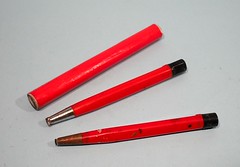 The fiberglass pencil was originally a draughtsman's tool. Rather than rub out marks with an eraser, they would use the fibreglass to remove them. I suspect this was mainly for working on film rather than paper but am happy to be corrected.
The fiberglass pencil was originally a draughtsman's tool. Rather than rub out marks with an eraser, they would use the fibreglass to remove them. I suspect this was mainly for working on film rather than paper but am happy to be corrected.In model railway terms they appeared as a tool for cleaning locomotive wheels - the model is turned upside down and power applied to the wheels. When they are rotating the fibre pen is used to polish them up. The beauty is that the fibreglass is softer than the wheel rim so the later isn't damaged as it can be when cleaned with a stiff brass brush as supplier by Triang or similar.
Beyond this, it's a very useful tool for cleaning excess solder from brass and nickel. You can also polish numbers and other transfers from ready to run models. This leaves a shiny patch but that's covered by replacement numbers or weathering.
I like to have a clean and dirty pen. The brass tipped ones is "clean" and used for wheel cleaning mainly. The other get used in kit building and soaks up grease and flux which I don't want on my wheels thank you !
The fat bundle is the same thing but less sophisticated. Bought from a model engineering show for a couple of quid, as opposed to the model railway one where it would be 6 or 8, it's a great solder scrubber. A blob can be spread out with plenty of flux over the surface, including rivet detail, and then polished away so no-one ever notices.
Safety note: The fibres do break off. If one get stuck in your finger, put some sticky tape over it and then remove. The glue usually grips the fibre and yanks it out in one piece and it's a lot easier than doing the same job with tweezers.
No comments:
Post a Comment